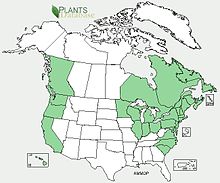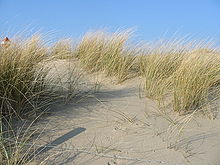- Ammophila (Poaceae)
-
Ammophila European Marram Grass
Dunes near The Hague, FebruaryScientific classification Kingdom: Plantae (unranked): Angiosperms (unranked): Monocots (unranked): Commelinids Order: Poales Family: Poaceae Genus: Ammophila
Host[1]Species - Ammophila arenaria (L.) Link
- Ammophila breviligulata Fernald
- A. champlainensis Seymour

The range of Ammophila in North America Ammophila (synonymous with Psamma P. Beauv.) is a genus consisting of two or three very similar species of grasses; common names for these grasses include Marram Grass, Bent Grass, and Beachgrass.[2] These grasses are found almost exclusively on the first line of coastal sand dunes; their extensive systems of creeping underground stems or rhizomes allow them to thrive under conditions of shifting sands and high winds. Ammophila species are native to the coasts of the North Atlantic Ocean where they are usually the dominant species on sand dunes. Their native range includes few inland regions, with the Great Lakes of North America being the main exception.[3] The genus name "Ammophila (Am-mó-phi-la) " originates from the Greek words of Ammos (ἄμμος), meaning sand, and Phillia (ϕιλος), meaning lover.
The Ammophila grasses are widely known as examples of xerophytes, which are plants that can withstand arid conditions such as deserts or sandy beaches. Its xerophytic adaptations (mentioned below) allow it to thrive under conditions most plants could not survive. Despite their occurrence on seacoasts, Ammophila grasses are not particularly tolerant of saline soils; they can tolerate a salinity of about 15 g/l (1.5%), which makes them "moderate halophytes".[4]
Ammophila builds coastal sand dunes and thus stabilizes the sand. For this reason, the plants have been introduced far from their native range. Alfred Wiedemann writes that, starting in the early 19th century, Ammophila arenaria "has been introduced into virtually every British colonial settlement within its latitudinal tolerance range, including southeast and southwest Australia, New Zealand, South Africa, the Falkland Islands, and Norfolk Island. It has been planted widely in Japan and has been reported from Argentina and Chile."[5] Ammophila species were introduced in the late 19th century on the Pacific coast of North America as well, and massive, intentional plantings were continued at least through 1960. In essentially all of the locations where they have been introduced, Ammophila plants are now listed as invasive, and costly efforts are underway to eradicate them.
Contents
Species
Only two species seem incontrovertible: A. arenaria and A. breviligulata. Two other species have been proposed, and are discussed below.
- A. arenaria - European Marram Grass or European Beachgrass. Native to coasts of Europe (north to Iceland) and northwest Africa. Inflorescence to 25 cm long; broad.
- A. baltica has now been identified as a natural hybrid, × Ammocalamagrostis baltica, between Ammophila arenaria and Calamagrostis epigeios. The hybrid occurs in parts of northern Europe, mainly from the Baltic Sea west to eastern England.
- A. breviligulata - American Marram Grass or American Beachgrass. Native to coasts of eastern North America, including the shores of the Great Lakes. Inflorescence to 30 cm long; narrower than A. arenaria.
- A. champlainensis or A. breviligulata ssp. champlainensis - Champlain Beachgrass. Native to shores of Lake Ontario and Lake Champlain. Inflorescence to 22 cm long; very similar to A. breviligulata, and no longer considered a distinct species by several authorities.[6][7][8]
Ecology
In Europe, Ammophila arenaria has a coastal distribution, and is the dominant species on sand dunes where it is responsible for stabilising and building the foredune by capturing blown sand and binding it together with the warp and weft of its tough, fibrous rhizome system. Marram grass is strongly associated with two coastal plant community types in the British National Vegetation Classification. In community SD6 (Mobile dune) Ammophila is the dominant species. In the semi-fixed dunes (community SD7), where the quantity of blown sand is declining Ammophila becomes less competitive, and other species, notably Festuca rubra (Red Fescue) become prominent.
Uses
The ability of marram grass to grow on and bind sand makes it a useful plant in the stabilization of coastal dunes and artificial defences on sandy coasts. The usefulness was recognized in the late 18th century.[9][10] On the North Sea coast of Jutland, Denmark, marram grass was traditionally much used for fuel, thatch, cattle fodder (after frost) etc. The use led to sand drift and loss of arable land. Hence, legislation promoting dune stabilization came into force in 1779 and 1792, successively leading to system of state-supported dune planters overlooked by dune bailifs. Marram grass was - and still is - propagated by root and shoot cuttings dug up locally and planted into the naked sand in periods of relatively calm and moist weather.
Newborough women once used marram grass in the manufacture of mats, haystack covers and brushes for whitewashing.
Marram grass has been widely used for thatch in many areas of the British isles close to the sea. The harvesting of marram grass for thatch was so widespread during the 17th century that it had the effect of destabilizing dunes, resulting in the burial of many villages, estates and farms. In 1695 the practice was banned by an Act of the Scottish Parliament:[11]
Considering that many lands, meadowes and pasturages lying on sea coasts have been ruined and overspread in many places in this kingdom by sand driven from adjacent sand hills .... His Majesty does strictly prohibit and discharge the pulling of bent, broom or juniper off the sand hills for hereafter.See also
References
- ^ "Species in GRIN for genus". www.ars-grin.gov. http://www.ars-grin.gov/cgi-bin/npgs/html/splist.pl?532. Retrieved 2008-04-24.
- ^ "Ammophila". Integrated Taxonomic Information System. http://www.itis.gov/servlet/SingleRpt/SingleRpt?search_topic=TSN&search_value=40447. Retrieved 19 September 2008.
- ^ Preston, C. D.; Pearman, D. A.; Dines, T. D. (2002). New Atlas of the British and Irish Flora. Oxford University Press. ISBN 978-0-19-851067-3.
- ^ "Comprehensive Report Species - Ammophila arenaria". NatureServe. http://www.natureserve.org/explorer/servlet/NatureServe?searchName=Ammophila+arenaria. Retrieved 2008-09-28.
- ^ Wiedemann, Alfred (1998-02-12). "Ammophila arenaria on the northwest coast of North America". Botanical Electronic News - BEN #183. http://www.ou.edu/cas/botany-micro/ben/ben183.html. Retrieved 2008-09-19.
- ^ "Ammophila champlainensis". Integrated Taxonomic Information System. http://www.itis.gov/servlet/SingleRpt/SingleRpt?search_topic=TSN&search_value=185263. Retrieved 6 September 2008.
- ^ The identification of Champlain beachgrass as a species that is distinct from A. breviligulata is still under investigation, and some authors consider Champlain beachgrass to be a subspecies A. breviligulata ssp. champlainensis (Seymour) P.J. Walker, C.A. Paris & Barrington ex Barkworth. Recent work on morphological differences between varying populations assigned to A. breviligulata and to A. champlainensis do not support the assignment of a distinct species for the latter specimens, despite significant differences. See Delisle-Oldham, M. B.; Oldham, M. J.; Catling, P. M. (2008). "Taxonomic Recognition of Ammophila champlainensis and Morphological Variation in Northeastern North American Ammophila (Poaceae)". Rhodora 110 (942): 129–156. doi:10.3119/07-07.1. http://www.bioone.org/perlserv/?request=get-abstract&doi=10.3119%2F07-07.1&ct=1. Retrieved 2008-09-21.
- ^ "Champlain Beachgrass Guide". New York Natural Heritage Program. http://www.acris.nynhp.org/guide.php?id=9716. Retrieved 2008-09-27.
- ^ Viborg, E. (1788) Efterretning om Sandvexterne og deres Anvendelse til at dæmpe Sandflugten paa Vesterkanten af Jylland. København. Full text (in Danish)(Subsequent German translation: Beschreibung der Sandgewächse und ihrer Anwendung zur Hemmung des Flugsandes auf der Küste von Jütland etc. Viborg, Erich Aus dem Dänischen von J. Petersen. Kopenhagen, 1789)
- ^ Andresen, C. C. 1861. Om Klitformationen og Klittens Behandling og Bestyrelse. - P.G. Philipsens Forlag. Full text (in Danish)
- ^ Gimingham, C. H. (1964). "Maritime and sub-maritime communities". In Burnett, J. H.. The Vegetation of Scotland. Edinburgh and London: Oliver & Boyd. pp. 67–142.
Gallery
-
European Marram Grass (left) with Velvet Bent (right).
-
American beachgrass on Lake Michigan in November.
External links
- California Conservation Corps, spearhead of Ammophila removal efforts in California.
- Jepson Manual Treatment
Categories:- Pooideae
- Flora of the Great Lakes region (North America)
- Poaceae genera
Wikimedia Foundation. 2010.





